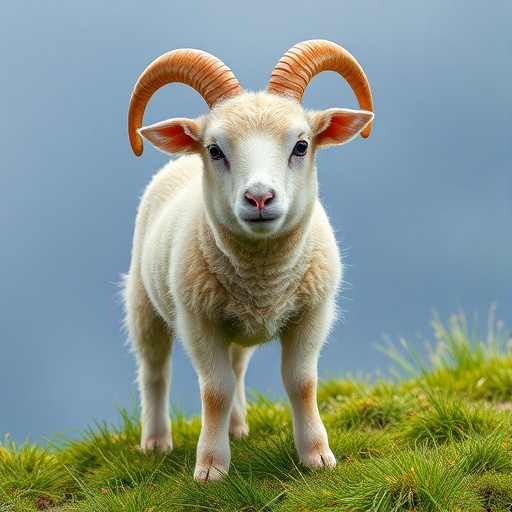New research has emerged in the fascinating intersection of genetics and livestock production, focusing on the role of specific genetic variants associated with the reproductive traits of sheep. The study, conducted by Al-Thuwaini et al., emphasizes the significance of a silent variant known as p.17Pro = SNP within the LHX4 gene, and its correlation with litter size in Awassi sheep. This groundbreaking discovery is not just an academic curiosity, but it carries profound implications for animal breeding practices, potentially enhancing efficiency in sheep production.
At the core of this research is the LHX4 gene, a crucial player in the regulation of reproductive functions among sheep. Gene variants, particularly SNPs or single nucleotide polymorphisms, have been widely noted for their influence on various traits in livestock. The specific involvement of the silent variant p.17Pro = SNP has raised intriguing questions regarding its functionality and overall influence on genetic expression related to reproductive success. As researchers delve deeper into these genetic intricacies, they aim to unlock the secrets behind prolific breeding in Awassi sheep.
Awassi sheep, known for their robustness and adaptability to arid climates, have captivated the attention of breeders seeking to optimize their productivity. The breed’s inherent advantages, paired with a deeper understanding of genetic factors affecting litter sizes, could lead to significant advancements in livestock farming. Enhanced litter size not only maximizes resource efficiency but also has the potential to improve the sustainability of sheep farming practices in challenging environments.
The significance of litter size in sheep production cannot be overstated. Litter size is a critical determinant of the productivity of breeding ewes, and increases in this trait can directly impact profitability for sheep farmers. With the silent variant p.17Pro = SNP demonstrated to be associated with an increase in litter size, this research opens the door to genetic selection strategies in breeding programs. Increasing awareness among farmers regarding this genetic factor can lead to more informed breeding decisions, ultimately yielding a more productive flock.
Furthermore, the study highlights the complexity of genetic interactions that govern reproductive traits. While the LHX4 gene variant provides one piece of the puzzle, the overall genetic landscape involves a multitude of factors that collectively determine reproductive performance. Jumping into the depths of genetics, the researchers encourage other scientists to further investigate the interplay between genetic variants and other environmental influences, which may also play a pivotal role in shaping reproduction in livestock.
In practical terms, implementing breeding strategies that harness the genetic knowledge gleaned from this study might take time and extensive validation. However, the prospect of enhancing sheep productivity through selective breeding based on genetic markers such as p.17Pro = SNP offers a promising avenue for the future of agriculture. These advancements can also contribute to the welfare of animals and responsibly enhance food production systems to meet growing global demands.
In addition to the insights provided on the LHX4 gene, the study’s findings may spur further research into the genetic basis of reproduction in other livestock species. As agricultural practices evolve to become more sustainable and efficient, understanding genetic contributions to reproductive success will be integral across various farming systems. By embracing a genetic approach to livestock management, producers can ensure the continuous provision of quality animal products while also aligning with ethical standards of animal husbandry.
The research conducted by Al-Thuwaini et al. serves as a critical reminder of the untapped potential that lies within genetic research. As technology improves and gene-editing techniques become more accessible, the possibilities of accelerating genetic improvements in livestock production are boundless. By focusing on silent genetic variants and their functional implications, the scientific community can harness genomic information to inform breeding decisions that are both economically beneficial and environmentally sustainable.
Ultimately, this research serves as a catalyst for change, urging the livestock industry to embrace genetic advancements that can reshape traditional breeding practices. The findings surrounding the LHX4 gene variant not only highlight the importance of scientific inquiry in the quest for better livestock but also reflect the potential for greater efficiency in food production, addressing the challenges posed by a growing population.
As more discoveries unfold in the complex arena of genetics, the knowledge accumulated will be invaluable in shaping future practices in livestock breeding. Researchers and farmers alike are encouraged to collaborate, sharing insights and data that can further illuminate the pathways to productive and healthy livestock populations. The future of sheep breeding, particularly in enhancing litter size, may very well hinge on our understanding of genetic nuances exemplified by studies such as this one.
In summary, the investigation into the silent variant p.17Pro = SNP in the LHX4 gene offers compelling insights into sheep reproductive traits with significant ramifications for the future of livestock breeding. As the sector aspires to meet elevated production standards amidst environmental challenges, embracing these genetic findings represents a forward-thinking approach that can lead to sustainable agricultural practices. The integration of genetic research into sheep breeding programs could very well be the key to securing advanced productivity in the face of an ever-changing world.
This groundbreaking research invites a plethora of further inquiries into the intricacies of genetics, urging the scientific community to continue unraveling the mysteries that lie within livestock genomes. The quest for optimal breeding strategies is not just a scientific challenge; it is a vital endeavor that resonates with the global need for sustainable food security for generations to come.
Subject of Research: Genetic association of silent variant p.17Pro=SNP in LHX4 gene with litter size in Awassi sheep.
Article Title: Association of Silent Variant p.17Pro = SNP in the LHX4 Gene with Litter Size in Awassi Sheep.
Article References:
Al-Thuwaini, T.M., Alkhammas, A.H., Rhadi, F.A. et al. Association of Silent Variant p.17Pro = SNP in the LHX4 Gene with Litter Size in Awassi Sheep.
Biochem Genet (2025). https://doi.org/10.1007/s10528-025-11223-y
Image Credits: AI Generated
DOI:
Keywords: LHX4 gene, litter size, Awassi sheep, silent variant, genetic markers, livestock breeding.




